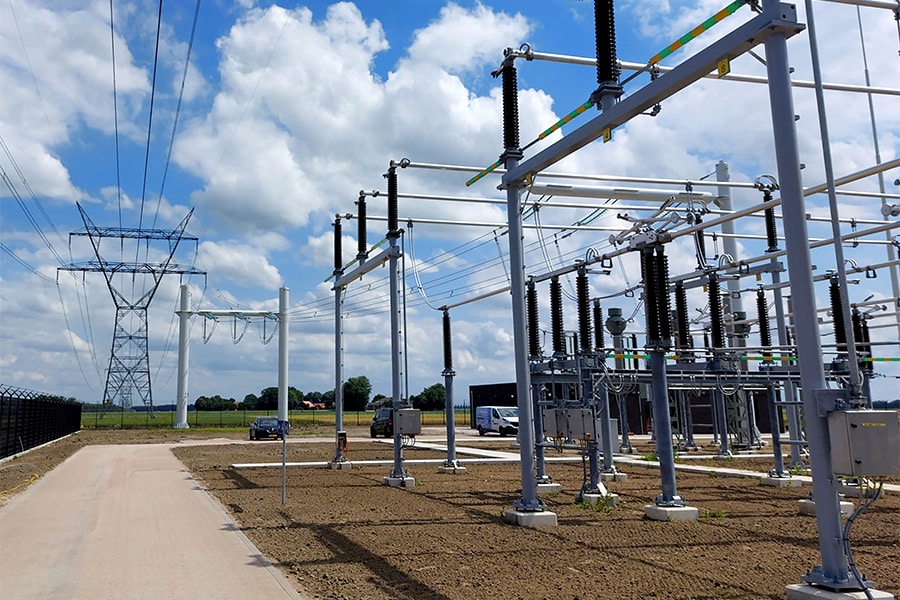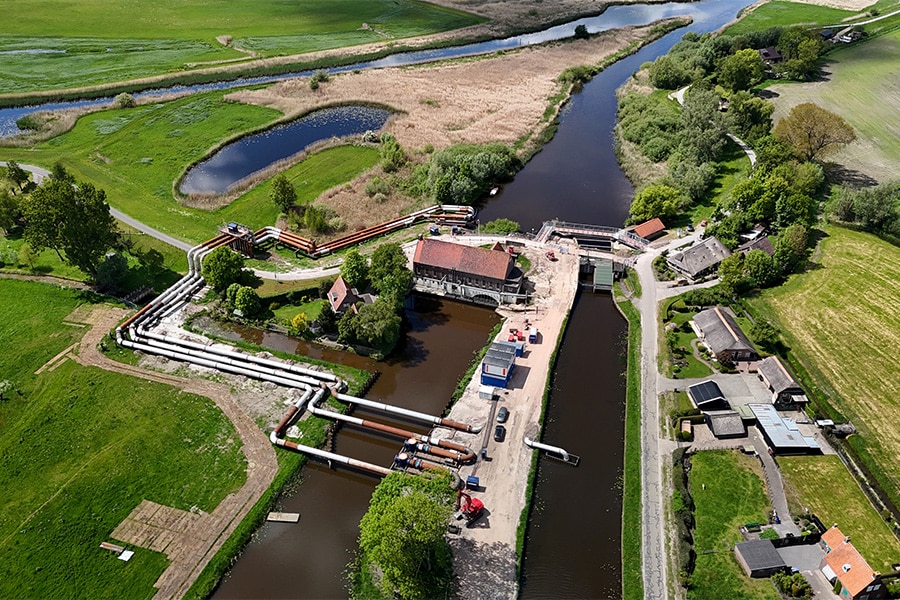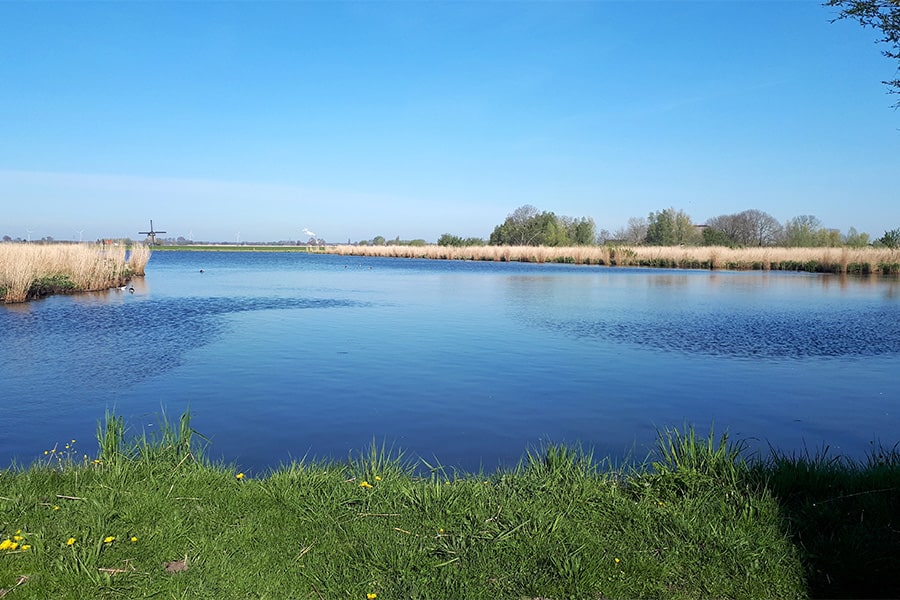
N307 Roggebot-Kampen: a project of extremes
Increasing water safety in the IJssel delta region, improving traffic flow and traffic safety on the N307 while adding spatial quality to the area. The N307 Roggebot-Kampen project is rightly one of extremes. Also exceptional are the 61-meter long tubular girders for the new Roggebot bridge, weighing 240 tons (!) each.
The provinces of Flevoland and Overijssel and the Ministry of Infrastructure and Water Management are jointly investing 100 million euros in the accessibility and water safety of the IJssel Delta region. "The N307 Roggebot-Kampen project is part of two larger tasks," said Guido Koolhaas, project manager for Flevoland province. "The IJsseldelta program (Room for the River) focused on water safety and nature development and improving the east-west connection between Alkmaar and Zwolle (the road from A to Z). The N307 Roggebot-Kampen project was awarded at the end of 2020 to Combinatie Roggebot, consisting of Mobilis, Van Gelder and Van den Herik."

Water system transition
The project includes the construction of a through road with 2×1 lanes for through traffic and parallel roads for slow and local traffic, the construction of a new and partly movable bridge over Lake Drontermeer and the construction of several smaller engineering structures, including a viaduct over the N307 for local traffic, a culvert bridge and several fauna passages. In addition, the flood defenses will be adapted to the new situation for water safety and the existing bridge over Lake Drontermeer, as well as the Roggebot lock, will be removed. "In the new situation, Drontermeer and Vossemeer will be connected," says Redmer Leegstra, environmental manager of combination Roggebot. "They are currently still two separate water systems, each with its own flood defenses. So to increase water safety in the area, a number of flood defenses are being strengthened and the Roggebot dam and lock are actually being removed. This is actually quite extraordinary. The transition of the water system and the flood defenses requires coordination with all parties and a well thought out and phased implementation of ground, water and dike work. Together with the water boards, Rijkswaterstaat and the province, we are ensuring that flood safety is guaranteed and that shipping and road traffic continue to flow as smoothly as possible."
From dike to dike
The N307 Roggebot-Kampen is a project where water, road and civil construction come together. "What stands out the most is the construction of the new bridge, right next to the existing bridge," acknowledges Robert Maat, project manager of combination Roggebot. "The design of the new bridge with a span of almost 300 meters from dike to dike is aimed at allowing as much water as possible to pass through in the new situation (Room for the River) and also to allow as much traffic as possible to pass through for a better and safer flow. In addition, the new bridge will also be a lot higher allowing more shipping traffic to pass without the bridge having to be opened and road traffic being blocked."
Uncategorized
Mobilis, Van Gelder and Van den Herik frequently realize integral projects together and complement each other well in terms of knowledge and expertise. "We also rely on a number of regular construction partners who are indispensable for bringing this project to a successful conclusion," says Maat. Haitsma Beton is one of them. "We supply and assemble the concrete girders for three structures on this project," says Bert van den Berg, project manager at Haitsma Beton. "The girders for the culvert bridge (38 pieces of HKO XL and 2 edge girders of 8 and 10 tons respectively) and the viaduct over the N307 have already been assembled. The viaduct involved quite substantial box girders (5 pieces of 135-ton HKP girders) in lengths of 45 meters." However, these are dwarfed by the exceptionally long ones for the new bridge over Lake Drontermeer, which link the provinces of Flevoland and Overijssel. For here, a total of 68 HIP girders were brought in in lengths of 54.5 and 34.7 meters and another 16 HKP tubular girders of 61 (!) meters. "Absolutely the outside category," assures Van den Berg. The new bridge consists of five fields. "The fields on the Flevoland side, consisting of 17 HIP girders of 87 tons and the 16 box girders of 240 tons, were brought in by water. From the pontoon in the lock, these girders were lifted directly into place with an impressive 650-ton crawler crane and a 700-ton mobile crane."

Similar appearance
Most of the girders for the Roggebot Bridge are already in place and the movable part of this bridge was lifted into place in September. Haitsma Beton was involved in the preliminary phase to help the engineering firm think about the technical and aesthetic details of this bridge. "The starting point is that the appearance of the bridge must be the same for all fields, while both tubular girders and HIP girders are used," says Van den Berg. "To achieve that, we used a so-called nose element to give the box girders the appearance of an HIP girder."
Blockage standing mast
By the way, not all girders of the new bridge are in place yet. This has to do with the availability of the waterway for the standing mast route. "The last girders will be assembled over several nights in mid-November," said Céline IJsseldijk, environmental manager for Flevoland Province. "From then on, ships with a clearance of more than 7 meters will temporarily be unable to pass.
This period designated "standing mast stoppage" will last from Nov. 15 to April 1, 2023. This is an exciting period for all of us. Partly because in the period starting March 13, 2023, traffic will be directed over the new bridge, after which the Combination will have until April 1 to prepare the channel under the movable part of the bridge. After that, demolition of the current lock complex will begin." Leegstra adds: "There is a lot going on this period, different disciplines are coming together in an area that is also still just in use for shipping and road traffic. It is therefore quite a challenge to gradually transition to the new situation without causing too much inconvenience."
Environmental Management
The project has many stakeholders, as it takes place in the area of two provinces, two water boards, two municipalities and the Department of Public Works. "It is important that everyone knows what is going to happen," says IJsseldijk. "This applies both to the residents and entrepreneurs in the area and to the final managers to whom we will soon hand over the various parts of the project." The environmental managers of the province and Combinatie Roggebot have many consultations among themselves. "We pull together to ensure that the various stakeholders are informed in a timely manner. In addition to the individual meetings, we send out a monthly newsletter about the progress of the work and invite interested parties and residents to an information evening at least twice a year." According to Leegstra, there is great interest from the surrounding area at every level. "Now that we are working outside with the implementation, we notice that there is more and more interest in visiting the project. We are also happy to take that up jointly with the province."
Safety comes first in everything we do, IJsseldijk emphasizes. "In addition, as a combination we are trying to coordinate the phasing in such a way as to limit inconvenience," Leegstra adds. "However, we do expressly ask the surrounding area to adhere to the speed limits and to keep paying attention, because the road route is subject to the necessary changes during the project. For those interested, a lookout point has been placed on the Drontermeerdijk to view the project safely and in peace and quiet." After traffic is directed over the new bridge as of March 13 and shipping has "unobstructed" passage again as of April 1, future high water drainage will also be secured in the second half of 2023, Koolhaas expects. "The most important milestones will have been reached by then. This will be followed by some residual work that will complete the project."



